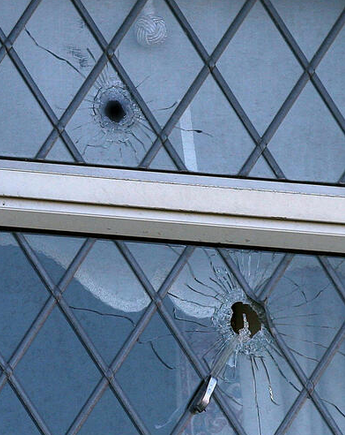Residential Security Updates in Light of Recent Events
We do quite a few executive residence risk assessments and security designs. I’ve been all over the country in some VERY NICE homes that all have had essentially the same thing in common: the owner wanted increased protection and peace of mind while they were in their home. Lately our work has been on an uptick and in light of recent events, I expect it to get even more busy.
On September 10, 2025, Charlie Kirk, a nationally known conservative commentator, was shot and killed during an event at Utah Valley University. The attack was allegedly carried out from a rooftop over a hundred yards away, demonstrating both planning and patience on the part of the assailant. Security personnel had concentrated on managing the crowd and immediate access points, but elevated sightlines outside the venue went largely unmonitored. The event revealed a hard truth: even when surrounded by a security detail, high-profile individuals remain vulnerable to simple but devastating tactics.
The implications go far beyond event security. For public figures, business leaders, and affluent families, the threat does not end when the lights dim on a public stage. Homes and private estates are increasingly within reach of the same risks. Assassinations and targeted violence are no longer confined to volatile regions or unstable regimes; they can now unfold on American soil, and they can just as easily take place in the supposed safety of one’s residence.
The threat landscape for residential protection has shifted dramatically. Where once the principal concern was burglary or opportunistic crime, the risks today include precision attacks from long range, sophisticated surveillance, and even aerial incursions. The proliferation of drones, coupled with the rapid innovations demonstrated on the battlefields of Ukraine, has shown how accessible and adaptable these tools have become for those with hostile intent. For individuals in the public eye, the possibility of drones being used for reconnaissance—or worse, as weaponized delivery platforms—cannot be dismissed.
In this new environment, residential protection must evolve from a focus on walls, locks, and cameras into a comprehensive system of layered defense. The physical structure of the home itself plays a vital role. Residences designed for security employ fortified entry points, ballistic-resistant glass, and safe rooms capable of withstanding direct assault. Landscaping and exterior design are carefully planned to prevent hiding places while providing clear sightlines for observation and detection. Lighting is layered and adaptive, ensuring that potential intruders cannot use darkness as cover.
Surveillance technology remains indispensable, but it must be deployed thoughtfully. Camera systems should be arranged in overlapping fields of view, covering all entrances, perimeters, and approach routes without leaving blind spots. Intrusion sensors, glass-break detectors, and intelligent analytics provide early warning of unusual activity. Yet technology alone is insufficient. It must be paired with trained personnel who understand both the strengths and limitations of the system, who can interpret patterns and respond decisively when threats arise.
Perhaps the most important lesson from the Kirk assassination is that the outer ring of security is often the most fragile. It is easy to secure the inside of a home, but vulnerabilities emerge from what lies just beyond the fence line. A neighboring building, a hillside with a direct line of sight, or even an adjacent public road can provide an attacker with the angle they need. Protecting against such threats requires not only awareness of the immediate property but also a constant evaluation of the broader environment.
Effective residential protection begins with a clear-eyed assessment of the risks facing a particular individual or family. Political visibility, public notoriety, and patterns of travel all influence the types of threats most likely to materialize. From that assessment, a strategy can be developed that layers defenses—outer perimeter, buffer zones, and inner sanctum—so that no single failure leaves the residence exposed. Equally important is redundancy. Power outages, communications failures, or equipment malfunctions must not cripple the system. Backup generators, secondary communications channels, and fail-safe procedures ensure continuity even under duress.
Yet while the security of a residence must be paramount, it cannot come at the cost of livability. A home must still feel like a home. Striking this balance is one of the greatest challenges of modern residential protection. The most effective designs integrate security measures seamlessly into the architecture and daily life of the family, maintaining comfort while quietly preparing for the worst.
The assassination of Charlie Kirk is a tragic reminder that prominent figures are not insulated from violence, no matter how secure they appear. For those at elevated risk, the responsibility to protect family and home demands more than a guard at the gate or a camera on the wall. It requires foresight, investment, and a willingness to confront uncomfortable realities. In today’s world, a secure residence is not a luxury. It is a necessity—and in many cases, it may be the only barrier between safety and catastrophe.
High-End Residential Protection Checklist
- Conduct full threat and risk assessment specific to the individual or family
- Harden perimeter with secure fencing, gates, and controlled access points
- Reinforce entryways and windows with ballistic-resistant materials
- Designate and equip a safe room with independent power, ventilation, and communications
- Install surveillance with overlapping fields of view, including rooftops and approach routes
- Integrate intrusion sensors, glass-break detection, and intelligent analytics
- Maintain trained, vetted residential security personnel with clear response protocols
- Coordinate in advance with local law enforcement for emergency response
- Eliminate blind spots and hiding places through landscaping and lighting design
- Assess and mitigate vulnerabilities from neighboring buildings or elevated sightlines
- Prepare for potential drone surveillance or attacks, informed by current global conflicts
- Ensure redundant power, communications, and fail-safe systems for continuity
- Review and update security measures regularly as threats and technology evolve
Posted in: CPTED
Leave a Comment (0) ↓